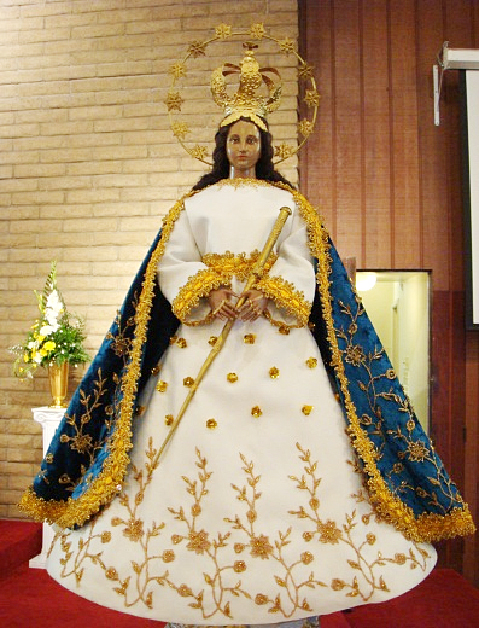 Novena of Masses
Novena of Masses
In Honor of
Our Lady of Peace and Good Voyage
Our Lady of Antipolo
| Day 1 | July 24 | Thurs | St. Joseph Mountain View | 6:30 PM |
| Day 2 | July 25 | Fri | St. Julie’s | 7:00 PM |
| Day 3 | July 26 | Sat | Our Lady of Guadalupe | 5:30 PM |
| Day 4 | July 27 | Sun | TBA | |
| Day 5 | July 28 | Mon | Our Lady of Peace | 6:00 PM |
| Day 6 | July 29 | Tue | Santa Teresa | 7:00 PM |
| Day 7 | July 30 | Wed | St. John the Baptist | 7:00 PM |
| Day 8 | July 31 | Thurs | St.Victor | 7:00 PM |
| Day 9 | Aug. 1 | Fri | TBA | |
| Fiesta | Aug. 2 | Sat | St. Justin | 12 Noon |
For more info: Lou (408) 439-9414; Poi (408) 729-7228; Eleanor (408) 227 5338
Diocese Celebrates the Feast of Our Lady Of Antipolo
The Diocesan Council of Filipino Catholics (DCFC), Diocese of San Jose, invites one and all to the annual celebration of the nine-day Novena Masses in honor of the feast of Our Lady of Antipolo, from July 24 through August 01, 2014 at different parishes. The highlight of the nine-day novena Masses will be the fiesta celebration to be held at St. Justin Parish on August 2nd at 12 noon.
Historical Background
In Antipolo, one finds the religious shrine of Our Lady of Peace and Good Voyage, popularly known as the Virgin of Antipolo (Birhen ng Antipolo). The origin of our Virgin of Antipolo dates back to Spanish era, when galleon trade between the Philippines and Mexico were at its height. On March 25, 1626, Don Juan Niño de Tabora left the shores of Mexico aboard El Almirante to make its voyage to the Philippines. On this trip, Governor Tabora brought along the brown image of our Blessed Virgin Mother.
For three months, the El Almirante safely braved the dangers of the stormy seas and a fire aboard the ship, arriving in the ports of Manila on July 18, 1626. Governor Tabora, realizing that the galleon’s safe and successful journey was due to the presence of the image of the Blessed Virgin on board, called for the pompous celebration of the image’s arrival. Amidst pageantry and fireworks, the procession started from the Church of San Ignacio, the Jesuit Church in Intramuros, up to the Manila Catholic Cathedral, the first house of the Blessed Virgin’s image. It is said that the events surrounding the safe voyage, the Blessed Virgin was named Nuestra Señora de la Paz y Buenviaje.
During the Japanese occupation, the Blessed Image of our Lady of Antipolo was evacuated to the mountains of Angono, then at Santolan. The five hundred people who journeyed with the Brown Virgin all felt safe through their trips along steep mountain trails. For a while, the Blessed Virgin was housed in the Ocampo residence at Quiapo, previous to its transfer to the Quiapo Church where it stayed until October 15, 1945, then finally got transferred to its original and permanent sanctuary at the Church of Antipolo. Every year, devotees commemorate this transfer, as they join the “Alay Lakad” from Quiapo Church to the Antipolo Cathedral starting at around 8:00 PM (30th of April) until dawn of the following day (1st of May). It is a national tradition in the Philippines to make a pilgrimage to Our Lady of Antipolo, particularly before departing for a long journey.
In 1994, the Board of Trustees of the National shrine of Immaculate Conception had approved the enshrinement of a statue of the Blessed Mother. A 200 year old replica was donated by the Mota sisters from Manila. And in 1995, Filipinos from across the United States raised funds to build an oratory for our Lady at the National Shrine of Immaculate Conception in Washington, D.C.. The Diocesan Council of Filipino Catholics of the Diocese of San Jose spearheaded the campaign in the diocese during her visit in July 1995.
The Oratory was opened on December 15, 1996 and was formally dedicated on June 7, 1997. Pilgrimages are being held annually by Filipino groups from dioceses across the United States
